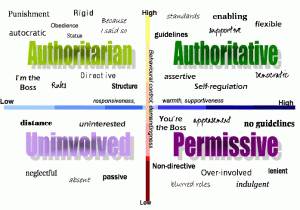So why grade?
Through last week’s blog and a recent episode of ‘Derek’, (where a girl on community service working in a retirement home started crying because she was told she was getting 10/10 and never had before) I decided that I wanted to focus on grading. The original aim was to ultimately assess individual achievement, a measurement tool for comparison between other student’s progression and the progression of personal learning. It has also become a form of currency within society, needed for employment and further educational practices. Furthermore, grades are often seen to be the predictor and assumption on the incentive of behaviour a student emits through study effort put in for exams and assignments.
Behaviourism
With this in mind, initial thought may be that there is a negative correlation between grades and showing high levels of studying behaviours within students, but it has been found not to strictly be the case. Birney (1964) through the use of questionnaires/interviews, reported that the value of a grade is in fact contingent upon the value of the course in terms of the amount of effort put into studying. This finding fully supports operant behaviourism, which states that learning is emitting behaviour based on reinforcement which has taken place in the past, so that the antecedents of the new behaviour include the consequences of previous behaviour.

In the case of Birney’s students: A: interest in the subject – B: studied hard – C: high grades (which motivated them to study hard again) OR A: not interest in the subject – B: didn’t study so hard – C: lower grades (little motivation to study again because the subject holds minimal value).
What affects ‘grade motivation’?
How are students motivated to study for the achievement of a high grade? Here are some possible determinants:
Ability
One factor found to contribute to grading and motivation is the self-concept of ability. Gottfried (1985) found that one through eighth graders’ academic intrinsic motivation inventory results positively correlated with school achievement, and negatively correlated with academic anxiety. Eccles et al., (1989) found similar results in sixth and seventh grade children; who rated self-concept of ability in parallel with the importance of the subject. In other words, if they thought they were particularly good at a subject, they thought it was of higher importance. Furthermore, Wigfield & Eccles (2000) proposed the ‘expectancy-value model’ stating that predicting children’s grades from their ability beliefs was often a predictor of results. Interestingly, Markus & Kitayama (1991) found that this does not correlate in all cultures; typically in American culture, an individual will strive to ‘…express their unique inner attributes’, and in Asian culture an individual will try to fit in with other’s when it comes to motivation and cognition.
Peer Influence
It has been found that adolecents are influenced more by their peers than parents (Coleman, 1961). Most school educational learning takes place in the classroom, where an individual is surrounded by their peers. Even when you reach university, it is common practice to discuss results. Schunk, Hanson & Cox (1987) found that when 10 year olds observed same-sex peers completing mathematical problems with coping skill levels as opposed to mastery skill levels, judged themselves as having similar competence and led to higher self-efficiency and skill. This notion follows the Social Learning Theory (Bandura & McClelland, 1977), as behavior is learned from the environment through the process of observation. Furthermore, it has been found that provided group rewards and individual accountability are put into practice, cooperative group learning has a hugely positive effect on student achievement compared to control groups (Slavin, 1983). This notion of ‘positive peer pressure’ could definitely be a major influence in motivation to achieve high grades.
Surely this is good…?
So far, I have covered the reasons why we strive for grades, but what about the negative influences of handing out grades?
Well, here are three points that certainly speak volumes:
Grades tend to diminish students’ interest in whatever they’re learning. The strive for high grades starts at a very early age, I certainly remember my teacher’s pushing for us to start thinking about university applications as young as 15 years old. But what has that done for our academic intrinsic motivation? It has been found because of the current need for having a university degree, the title is now more important for students than the information learnt on the course (Kuh, 2001).
Grades create a preference for the easiest possible task. I’m sure many of you will think back to first year when everyone was heard muttering ‘First year doesn’t count towards your final degree’. Those who do just scrape 40%, this one applies to you! However, as we were indeed told in one of our first lectures and as McKenzie and Schweitzer (2001) have found, achieving high grades in the first year of university is a high predictor of overall university achievement, so maybe they should have been looking ahead?
Grades tend to reduce the quality of students’ thinking. Grolnick and Ryan (1987), found that students had more trouble understanding the main point of a text passage if they were told it was going to be graded, than students that were told no grades would be involved. Furthermore, the ‘non-graded’ group could recall more facts regarding the passage a week later than the ‘graded’ group.
To conclude..
Grading obviously has a big impact on intrinsic motivation and there are a fair few factors affecting it. Operant conditioning may explain the personal reasons for wanting to achieve high grades as well as the social learning theory for peer influences. However, it is clear that the notion of handing out grades squashes interest and student thinking (creativity perhaps?).

Sorry the blog is a little lengthy this week – there was so much to write about and I was intrinsically motivated!
References:
Birney, R. C. (1964). The effects of grades on students. The Journal of Higher Education, 35(2), 96-98.
Podsakoff, P. M., MacKenzie, S. B., & Organ, D. W. (2005). Organizational citizenship behavior: Its nature, antecedents, and consequences. Sage Publications, Incorporated.
Eccles, J. S., Wigfield, A., Flanagan, C. A., Miller, C., Reuman, D. A. and Yee, D. (1989), Self-Concepts, Domain Values, and Self-Esteem: Relations and Changes at Early Adolescence. Journal of Personality, 57: 283–310. doi: 10.1111/j.1467-6494.1989.tb00484.x
Gottfried, A. E. (1985). Academic intrinsic motivation in elementary and junior high school students. Journal of Educational Psychology, 77(6), 631.
Wigfield, A., & Eccles, J. S. (2000). Expectancy–value theory of achievement motivation. Contemporary educational psychology, 25(1), 68-81.
Markus, H. R., & Kitayama, S. (1991). Culture and the self: Implications for cognition, emotion, and motivation.
Psychological Review; Psychological Review,
98(2), 224.
Bandura, A., & McClelland, D. C. (1977). Social learning theory.
Kandel, D. B., & Lesser, G. S. (1969). Parental and peer influences on educational plans of adolescents.
American Sociological Review, 213-223.
Slavin, R. E. (1983). When does cooperative learning increase student achievement?. Psychological Bulletin, 94(3), 429.Kuh, G. D. (2001).
Kuh (2001) Assessing What Really Matters to Student Learning Inside The National Survey of Student Engagement. Change: The Magazine of Higher Learning, 33(3), 10-17.
Grolnick, W. S., & Ryan, R. M. (1987). Autonomy in children’s learning: An experimental and individual difference investigation. Journal of Personality and social Psychology, 52(5), 890.
McKenzie, K., & Schweitzer, R. (2001). Who succeeds at university? Factors predicting academic performance in first year Australian university students. Higher education research and development, 20(1), 21-33.





